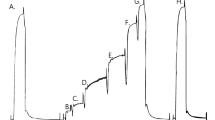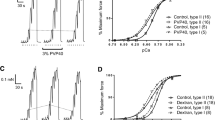Abstract
The effects of the polar amino acid glycine (20 mmol l−1) and the non-polar amino acid proline (20 mmol l−1) on Ca2+-activated contraction have been examined in four types of striated muscle fibres. Single fibres dissected from the claw muscle of a crustacean (long- and short-sarcomere) and the hindlimb muscles of the rat (slow-twitch from soleus and fast-twitch from extensor digitorum longus) were activated in matched solutions that either contained the amino acid (‘test’) or not (‘control’). The steady-state force produced in these solutions was used to determine the relation between force production and pCa (−log10[Ca2+]). The results show that in the concentrations used, glycine and proline had only small effects on the maximum Ca2+-activated force, pCa corresponding to 10, 50 and 90% maximum force (pCa10, pCa50, pCa90, respectively) or on the slope of the force-pCa curves in the four different fibre types. The relative lack of effects of glycine and proline on contractile activation would confer a distinct physiological advantage to force production of muscle of Cherax, where the concentrations of glycine and proline vary considerably. Finally, the results show that glycine and proline may be useful to balance control solutions when the effects of other amino acids or zwitterions on contractile activation are examined.
Similar content being viewed by others
References
Armstrong RB and Phelps RO (1984) Muscle fibre composition of the rat hindlimb. Am J Anat 171: 259–272.
Ashley CC, Lea TJ, Hoar PE, Kerrick WGL, Strang PF and Potter JD (1991) Functional characterisation of the two isoforms of TnC from the arthropod Balanus nubilus. J Muscle Res Cell Motil 12: 532–542.
Ashley CC and Moisescu DG (1977) Effect of changing the compo-sition of the bathing solutions upon the isometric tension-pCa relationship in bundles of crustacean myofibrils. J Physiol 270: 627–652.
Ashley CC, Mulligan P and Lea TJ (1991) Ca 2 + and activation mechanisms in skeletal muscle. Quart Rev Biophys 24: 1–73.
Ashley CC and Ridgway EB (1970) On the relationships between membrane potential, calcium transient and tension in single barnacle muscle fibres. J Physiol 209: 105–130.
Bakker AJ and Berg HM (2002) Effect of taurine on sarcoplasmic reticulum function and force in skinned fast-twitch skeletal muscle bres of the rat. J Physiol 538: 185–194.
Bergstrom J, Furts P, Noree LO and Vinnars E (1974) Intracellular free amino acid concentration in human muscle tissue. J Appl Physiol 36: 693–697.
Bortolotto SK, Cellini M, Stephenson DG and Stephenson GMM (2000) MHC isoform composition and Ca 2 +-orSr 2 +-activation properties of rat skeletal muscle fibres. Am J Physiol 279: C1564–C1577.
Close RI (1972) Dynamic properties of mammalian skeletal muscles. Physiol Rev 52: 129–197.
Dooley PC, Crouch PJ and West JM (2002) Free amino acids in claw muscle and haemolymph from Australian freshwater crayfish at different stages of the moult cycle. Comp Biochem Physiol A 131: 625–637.
Dooley PC, Long BM and West JM (2000) Amino acids in haemolymph, single fibres and whole muscle from the claw of freshwater crayfish acclimated to different osmotic environments. Comp Biochem Physiol A127: 155–165.
Galler S, Hutzler C and Haller T (1990) Effects of taurine on Ca 2 +-dependent force development of skinned muscle fibre preparations. J Exp Biol 152: 255–264.
Holroyde MJ, Robertson SP, Johnson JD, Solaro RJ and Potter JD (1980) The calcium and magnesium binding sites on cardiac troponin and their role in regulation of myofibrillar adenosine triphosphatase. J Biol Chem 255: 1168–1193.
Julian FJ (1971) The effect of calcium on the force–velocity relation of briefly glycerinated frog muscle fibres. J Physiol 218: 117–145.
Kihara Y, Inoko M and Sasayama S (1995) L-methionine augments mammalian myocardial contraction by sensitising the myofilament to Ca 2 +. Circ Res 77: 80–87.
Li Y and Mykles DL (1990) Analysis of myosins from lobster muscles: fast and slow isozymes differ in heavy chain composition. J Exp Zool 255: 163–170.
McGuigan JA, Luthi D and Buri A (1991) Calcium buffer solutions and how to make them: a do it yourself guide. Can J Physiol Pharmacol 69: 1733–1749.
Miller DJandSmithGL(1984) EGTApurity and the bufferingof calcium ions in physiological solutions. Am J Physiol 246: C160–C166.
Moisescu DG and Pusch H (1975) A pH-metric method for the determination of the relative concentration of calcium to EGTA. P. u ¨gers Archiv 355: R122.
Moisescu DG and Thieleczek R (1978) Calcium and strontium concentration changes within skinned muscle preparations follow-ing a change in the external bathing solution. J Physiol 275: 241–262.
Mykles DL (1985) Heterogeneity of myo brillar proteins in lobster fast and slow muscles: variants of troponin, paramyosin, and myosin light chains comprise four distinct protein assemblages. J Exp Zool 234: 23–32.
Patterson MF, Stephenson GMM and Stephenson DG (2001) A study of the short-term effects of glucose 6-phosphate on the contractile activation properties of skinned single muscle fibres of the rat. Implications for solution design. P. u ¨gers Archiv 442: 874–881.
Rees BB and Stephenson DG (1987) Thermal dependence of maximum Ca 2 +-activated force in skinned fibres of the toad Bufo marinus acclimated at different temperatures. J Exp Biol 129: 309–327.
Schachat FH, Bronson DD and McDonald OB (1985) Heterogeneity of contractile proteins. J Biol Chem 260: 1108–1113.
Schachat FH, Diamond MS and Brandt PW (1987) Effect of different troponinT–tropomyosin combinations on thin lament activation. J Mol Biol 198: 551–554.
Stephenson DG, Stewart AW and Wilson GJ (1989) Dissociation of force from myofibrillar MgATPase and stiffness at short sarcomere lengths in rat and toad skeletal muscle. J Physiol 410: 351–366.
Stephenson DG and Williams DA (1981) Calcium-activated force responses in fast-and slow-twitch skinned muscle fibres of the rat at different temperatures. J Physiol 317: 281–302.
Suleiman M-S, Fernando HC, Dihmis WC, Hutter JA and Chapman RA (1993) A loss of taurine and other amino acids from ventricles of patients undergoing bypass surgery. Br Heart J 69: 241–245.
Swynghedauw B (1986) Developmental and functional adaptation of contractile proteins in cardiac and skeletal muscles. Physiol Rev 66: 710–771.
Szent-Gyo ¨rgyi AG and Chantler PD (1994) Control of contraction by calcium binding to myosin. In: Engell AG and Franzini-Armstrong C (eds) Myology, 2nd ed.
West JM, Barclay CJ, Luff AR and Walker DW (1999) Developmental changes in the activation properties and ultrastructure of fast-and slow-twitch muscles from fetal sheep. J Muscle Res Cell Motil 20: 249–264.
West JM, Humphris DC and Stephenson DG (1992) Differences in maximal activation properties of skinned short-and long-sarco-mere muscle fibres from the claw of the freshwater crustacean Cherax destructor. J Muscle Res Cell Motil 13: 668–684.
West JM and Stephenson DG (1993) Ca 2 +-and Sr 2 +-activation properties of skinned muscle bres with different regulatory sys-tems from crustacea and rat. J Physiol 462: 579–596.
Wilson GJ, dos Remedios CG, Stephenson DG and Williams DA (1991) Effects of sulphydryl modification on skinned rat skeletal muscle fibres using 5, 5′-dithiobis (2-nitrobenzoic acid). J Physiol 437: 409–430.
Author information
Authors and Affiliations
Corresponding author
Rights and permissions
About this article
Cite this article
Powney, E., West, J., Stephenson, D. et al. Effects of glycine and proline on the calcium activation properties of skinned muscle fibre segments from crayfish and rat. J Muscle Res Cell Motil 24, 461–469 (2003). https://doi.org/10.1023/A:1027325614299
Issue Date:
DOI: https://doi.org/10.1023/A:1027325614299




